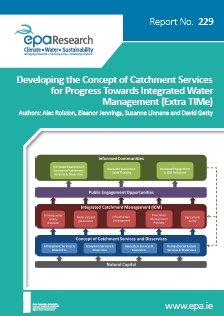Authors: Alec Rolston, Eleanor Jennings, Suzanne Linnane and David Getty
Summary: The benefits and disservices received by people and ecosystems within catchments are called catchment services and disservices. Their delivery can be influenced by multiple factors including climate, legislative/policy and social (demographic) change.

The research showed that the sensitivity of catchment services and disservices to future climate change projections varied, with water balance/yield, aquifer recharge, crop yield and water abstraction being the services most sensitive to climate change. The over-abstraction of water resources, flooding and drought were the disservices found to be most sensitive to climate change. As environmental and social policies influence catchment services in different ways, integrated policy development is needed to work across the land-use and water management realms that underpin the principles of Integrated Catchment Management. This will minimise negative impacts of future policy on the delivery of catchment services and help negate the delivery of catchment disservices. Ireland’s future population growth will affect multiple catchment services and disservices. Impacts include habitat loss, increased infrastructure development, deteriorated surface water and groundwater quality, increased litter dumping, loss of agricultural area, and increased urban sprawl. Mitigating impacts on catchment services and disservices will be dependent on future housing, infrastructure and social planning policies.
The concept of catchment services and disservices has the potential to underpin environmental and social policy and legislation. Therefore, there are implications for current water governance and engagement across both agencies and communities. The research identified 13 key gaps that currently exist between
For agencies implementing water-related legislation, clear guidance is required as to how the concept of catchment services and disservices can inform management actions. In addition, further understanding is required as to how multiple catchment services and disservices may be affected by the enforcement of relevant regulations.
The research identified that there are opportunities for the concept of catchment services and disservices to underpin key policy initiatives in to the future, such as current and future rounds of EU WFD river basin management planning, and the National Planning Framework (Ireland 2040-Our Plan). However, targeted engagement actions are required within and external to the proposed WFD Implementation Structure, to raise awareness of the concept of catchment services and disservices and how the concept can inform high level policy and management actions. The research has developed a five-phased approach for communicating the concept of catchment services and disservices in Ireland, and has identified a series of actions that will increase awareness of the concept across both governing agencies and local communities.
https://www.epa.ie/media/epa-2020/publications/research/Research_229_thumbnail[1].jpg